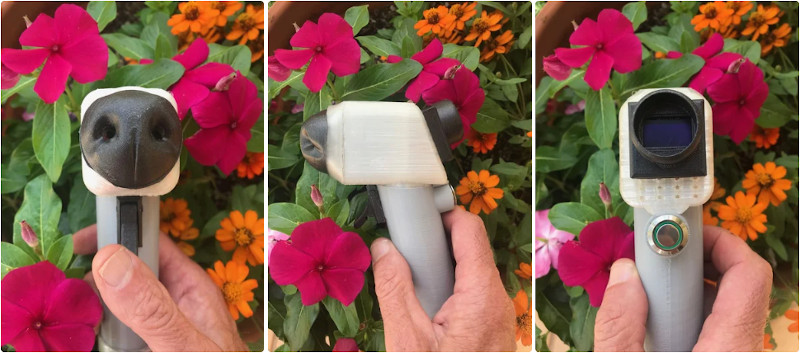When measuring air quality, particulate matter is an important metric to watch. The PM2.5 rating refers to particulate matter that has a diameter of less than 2.5 micrometers. While it’s often measured by authorities on a city-wide basis, [rabbitcreek] wanted a way to track down point sources indoors.
The tool [rabbitcreek] built is in a similar form factor to a typical infrared workshop thermometer. Inside, it packs a Honeywell HPMA115S0-TIR laser particle sensor, hooked up to an ESP32 which runs the show. The sensor chosen makes things easy, with the device already set up with a blower and inlet and outlet ports for taking accurate readings.. Results are displayed on an SSD1306 OLED screen. It’s all wrapped up in a 3D printed case with a trigger grip, and a dog nose on the front which hints at the devices true purpose.
In testing, the device proves capable of detecting point sources of atmospheric particulates like flowers and a toaster. It’s something we’re sure would prove handy to those working in HVAC and environmental assessment industries. We’ve seen other rigs for monitoring particulates before, too. Video after the break.















Just struggling to see what the number is.
https://laqm.defra.gov.uk/public-health/pm25.html
tells me mass of particles under 2.5 um per cubic metre of air.
So when that thing says (for example) 500 does that mean 500 particles have been detected having pumped 1 m^3 through the device or is 500 the mass, in some undefined unit, of an unknown number of particles that were all under 2.5um in 1 m^3 of air?
The sensor has built in fans.
The readings are PPM of P2.5 particulate in the sample of air drawn through the unit.
PPM being?
Parts per cubic metre. It more normally means parts per million to me but that can’t be right as there is no “million” anywhere to have parts in.
It’s like percent (per cent, meaning per 100), but permillion is per million, so 1 per 1 000 000, so 500 PPM is 0,05% and that’s mass.
Not to be confused with promiles, which are parts per thousand.
Still does not make sense to me. If I have 1 lb of carrots in 10 lb of potatoes how many PPM is that?
Particle size of air is what? The size of the molecule? Are we talking 500 grams of small particles in 1,000 kilograms of air? That’s a lot of air.
Just trying to make sense of the numbers and I can’t.
The spec sheet lists it as µg/m3.
This is correct. The “PPM” shown on the display is a misspelling of “PM”. Not visible in the photo but to the right is “2.5”. So it is saying it is measuring in the PM2.5 range as opposed to the PM10 range.
High end particle detection instruments have filters of various sizes and weigh them after a certain amount of air has passed – hence the standard micrograms per cubic meter measurement. The cheap detectors count particles and use an algorithm to estimate the µg/m3 measurement.
Cheers. That cleared it up. :)
To clarify my nearby reply: PM2.5 refers to atmospheric particulate matter (PM) that have a diameter of less than 2.5 micrometers.
Particulate sensors based on the light diffraction measure numerical concentration directly (number of particles in unit volume of air, usually per cubic meter). But the problem is that professional measurements are done by measuring mass of particles in unit volume of air (usually by filtering known amount of air on the filter with known mass). Therefore these low cost particulate sensors calculate mass concentration of particles based on numerical concentration, assuming that all particles are spherical and the specific density is constant and known (it’s not).
For this sort of use though, you only need it to be self consistent really. It’s bigger over here and smaller over there…
This sort of thing will be great for testing filters for use with my COVID19 Filtered Face Mask project. Thanks!
https://hackaday.io/project/170580-filtered-face-mask